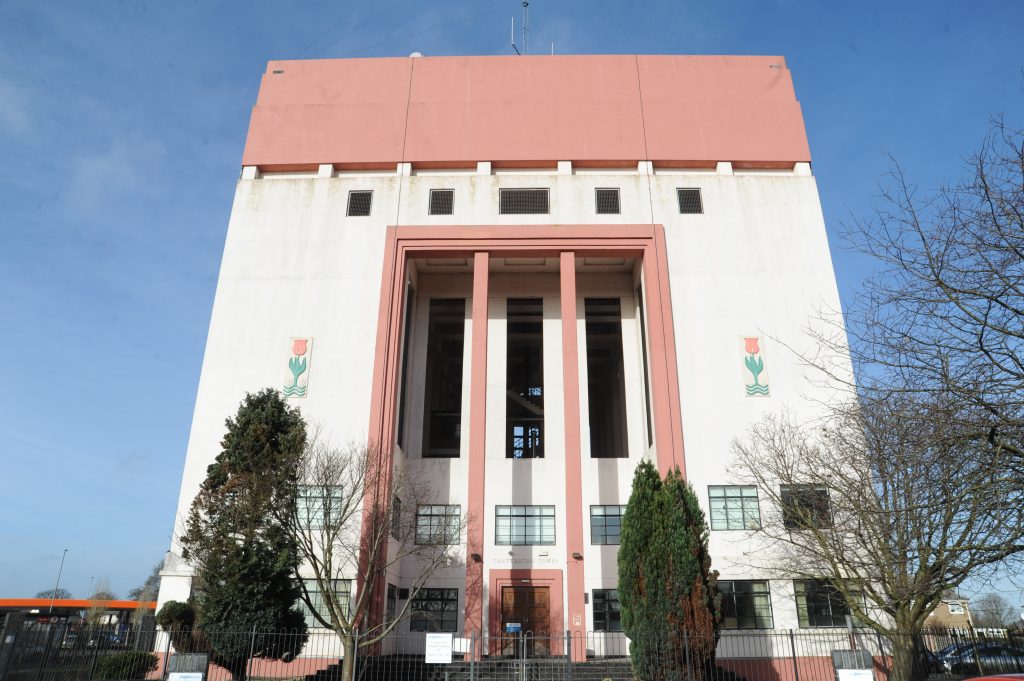It’s a massive landmark able to be seen from miles around and it is due to undergo a facelift this year. You might have passed it hundreds – or even thousands of times – but what do you actually know about the water tower in Spalding? And where does that H2O come from? To find out more, news editor Nigel Chapman took a look inside Chatterton Tower (note the omission of “Water” in its title, which it often wrongly attracts).
If your home or workplace is one of the 22,000 properties in the Spalding area served by Chatterton Tower, then the product which flows when you turn on a tap there will have passed through the building in Winfrey Avenue.
Built in 1955, many Anglian Water customers have been through its front doors, clutching their bill and method of payment, but its use as a billing office has long since passed.
Now the mammoth building’s insides are somewhat forlorn with some large, empty and rather unsightly offices; but with fewer than ten people working there at any one time – and sometimes only fleetingly to jump on the network – it matters little.
However, the water tower’s main purpose – to provide a storage head for clean, fresh water – is as important now as it ever was, and that won’t change.
The tower has two tanks with a total capacity of 3,400 cubic metres, capable of storing 3,400,000 litres of water but usually having between 70 and 90 per cent of that amount.
The fresh water comes in via an 18in pipe from Bourne treatment works, situated at the junction of Abbey Road and Manning Road, and leaves via another.

The Spalding area has a lot of industry requiring a good supply of water during the daytime and the normal rate at which the tower delivers is 60 litres per second, at pressure of 3 bar.
However, when demand is higher – such as between 6am and 8.30am when people are bathing and showering and at night just before they head for bed – the supply increases with it.
The water starts its journey to Spalding when it’s drawn from the ground at Bourne via two boreholes. Anglian Water has an abstraction licence for a maximum of 25 million litres per day there, though the norm is around 16 million.
The water passes through an aeration process to oxygenate it and chemicals including chlorine are added prior to contact time to allow for disinfection. The water then undergoes a turbidity check for its clarity.
Mick Cox, Anglian Water’s water supply manager for the area, said: “The water coming out of the bore holes is very high quality.
“Bourne has six booster pumps which directly feed the Bourne network and Spalding.”
For many areas, water is derived half via boreholes and half via reservoirs but in Mick’s patch the bore hole method is dominant.
There are nine such treatment works – at Bourne, West Pinchbeck, Wilsthorpe, Billinghay, Clay Hill, Pilsgate, Tallington, Aswarby – and a surface water treatment works at Saltersford, near Grantham, which is supplied by Rutland Water. Clean water is stored in nine water towers (such as in Spalding) and 14 service reservoirs (such as at Wilsthorpe).
Mick said: “If we are not using water towers or service reservoirs we use pumps to ensure the pressure is maintained.”
He oversees a team on 24-hour standby comprising one support manager, 15 technicians (covering mechanical, electrical and process) and one admin member.
Also overseeing the area is IRIS, a remote telemetry monitoring unit providing data on flows, pressures, quality and security.
“IRIS is why we can run such a large area with a relatively small team,” Mick added.
Another benefit of Chatterton Tower unrelated to the wet stuff? The reception of your mobile phone signal. The 100ft-high building has masts on top for all the main network operators.

Water supply manager Mick Cox – a former engineering apprentice who has been with Anglian Water for more than 20 years – is an example of the experience and calibre of staff within the company.
And it is keen to provide support to enable a constant supply of people with the necessary skills to keep the business running smoothly – a steady flow, if you will.
Working alongside Mick currently is Patrick Adesite, who studied for a Masters in chemical engineering, graduating from Lough-borough University last year.
The 23-year-old Londoner said: “I’m now on a two-year programme, with a four-month rotation around the departments, such as water supply and water recycling (sewage treatment). It gives me real-life experience with the managers.”
Mick said: “We want to encourage engineers because we need them. It’s why our apprenticeships and graduate schemes are really important.”
Anglian Water is the main employer sponsor of Greater Peterborough University Technical College, which specialises in engineering and construction.







